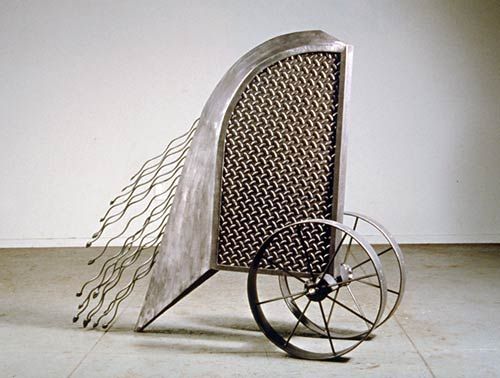 |
Bella Feldman is a remarkable and prolific artist whose long career has largely been spent as a sculptor of evocative objects. Her current show at the Richmond Art Center—a packed and rambling survey of nearly 100 works created since the early 1970s—leads the viewer on a journey through the artist’s life, politics, extensive travels and artistic concerns. While the breadth of Feldman’s technical and thematic explorations are impressive, and alternately inspire a sense of delight, fascination, and dread, my initial experience of her show was one of being visually overwhelmed, as the choice to present a comprehensive survey of her oeuvre is compromised by the limited space of RAC’s galleries. The Center’s Main Gallery — packed with floor- and pedestal-based sculpture, and topped with wall-mounted two- and three-dimensional works — was reminiscent of a curiosity shop. Yet, despite the seeming lack of curatorial selection that would allow Feldman’s work to breathe, her show can also be considered a Wunderkammer (cabinet of wonders), in which close consideration of individual works encourages comparisons and consistently inspires a sense of admiration and deserved contemplation.
 |
.jpg) |
The earliest example in this show is Feldman’s Rat Sequence (1972-74), which emerged from teaching for two years in Uganda. The experience motivated her to cast rats as a metaphor for men, and aluminum shavings as a metaphor for human struggle, evolution, genetic scientific testing, and the effects of nuclear war. This was followed by her Membrane Series from the late 1970s, an alternately whimsical or threatening group of anthropomorphic fiberglass sculptures that were created during the Cold War, when Feldman shared the collective apprehension about nuclear warfare. During the later 1980s Feldman created a number of zinc-plated steel and graphite sculptures—Excedra, Bullfinches Chariot, and The Edge of Reason (1987-89) — that visually allude to ancient Roman chariots and combat apparatus.
The additional inclusion of pieces created over the past three years from her recent series RPM (2010-11) and Out of Order (2012-13), as well five recent paintings (2010-13) reveal her ongoing fascination (or self-described “love-hate relationship”) with machines. While the paintings and RPM works reveal a strong alliance with Constructivist aesthetics, her Out of Order sculptures—comprised of layers of glass engraved and juxtaposed with metal cogs and other machine parts—suggest strong conceptual alliances with the machine aesthetic and unrealized potential inherent in Marcel Duchamp’s The Large Glass (1923). These new works demonstrate both the consistency of Feldman’s vision, as well as her ongoing commitment to experimentation.
 |
Feldman’s show is truly “Bella,” but there is too much work; the galleries are crowded and each series could be represented by fewer examples. The Minimalist tenet, “less is more,” is particularly germane to the aesthetic that guides Feldman’s artistic expression. The monumental sculptures from her Reach (2007) and Larger War Toys (1987-2011) series are powerful, and the exhibition would benefit from spacious placement of these, complemented by a more judicious selection of smaller sculptures and paintings. The development of Bella Feldman’s artistic expression through her 50- year career would be heightened by such a Wunderkammer, deservedly highlighting her exceptional strength of ideas and execution.
-TERRI COHN
“Bella: A 50-year survey of the work of Bella Feldman” @ Richmond Art Center through November 15, 2013.